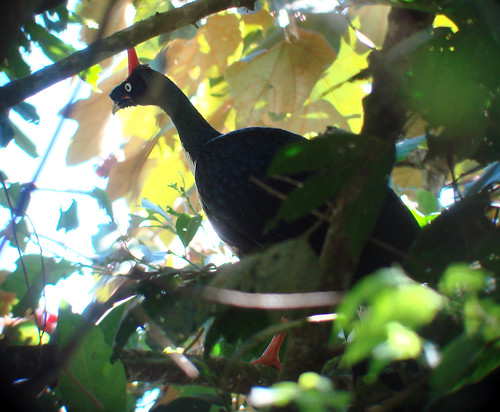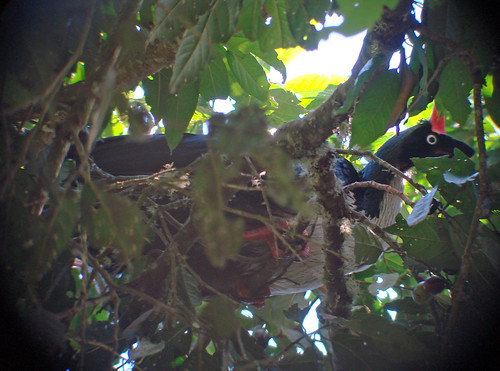 |
| These are the socks I wore on my hike to see the Horned Guan in Guatemala in 2007. Photo was taken in 2016, so the stains have faded. |
This pair of socks earned their colors in February 2007 on a hike to one of
the most remote spots on the planet to see one of the rarest birds in the
world—the Horned Guan. I was with three professional tour leaders staying at a
lovely coffee plantation in Guatemala—a plantation that was literally at the
end of the road. Two local guides, one experienced and with excellent English,
one a teenager just starting to learn English, woke us up at 2 a.m. so we could
reach the highlands at dawn—the best time to view the guan munching its leafy
breakfast in the treetops. We started out in a jeep that took us up and up the
volcano, along a bumpy trail far too narrow to accommodate a truck—branches
whipped our faces as we rattled along in the dark. After an hour, the trail
ended and out we hopped, flashlights in hand, to hike a narrow path hacked by
hand through the forest. It was 3:30 am, too early for even a slight grayness
on the eastern horizon, and we had a long way to go before we reached the area
where the guan was supposed to be—they said it would be at least a three hour
hike from here.
The other three birders were gung ho guys in their thirties,
antsy to charge forward and get that guan. None of them brought a camera or spotting
scope—one even forgot his flashlight. I tend to be pretty laid back and
methodical even when I’m excited—I figured I was either going to see the guan
or I wasn’t, and if I did, I wanted a photo. And I wanted to bird along the
way. I was twenty years older than they, and didn’t want to slow them down. So
the older guide took them ahead while the younger moseyed back with me,
carrying my scope. Every now and then we tripped on stumps of saplings jutting out
of the ground in the pitch darkness. Our boots kept sinking into the coarse,
loose volcanic ash, making the footing more treacherous. And with every step,
my feet seemed to be getting heavier—which they actually were, since so much
ash was seeping into them.
My Spanish was rusty, but my guide and I managed to carry on
a conversation. With the endearing tactlessness of a teenager, my asked how old
I was, and when I said 55, he gasped with surprise, blurting out that I was
older than his grandmother. He said I might be the oldest woman ever to have
made that trip.
The others hiked at a rapid clip, and found a guan around 7:30—their
guide called mine on his cell phone. We still had a long way to go—it took us over
an hour to catch up. But they kept the guan in sight the whole time to make
sure I saw it too.
The bird was worth every moment of the hike, every grain of
volcanic ash scraping against my feet inside my boots. Horned Guans are as big
and plump as turkeys, with iridescent black and white plumage. A brilliant red
horn juts out of their forehead as if they were unicorns. I gazed at it for
half an hour, but never saw the entire bird at once—wherever it moved in the
canopy, leaves always managed to obscure parts of it. I snapped dozens of
photos, lovely mementos of this splendid bird.
My stained socks serve as a more
visceral reminder of the long climb up, and the longer, more treacherous trip
back down through the gritty ash. I was exhausted when we finally made it back
to the lodge after a five-hour descent and another hour in the jeep. The first
thing others said when we arrived was that we’d want to throw out our socks. I
just smiled and tucked them safely in a bag for the journey home.


